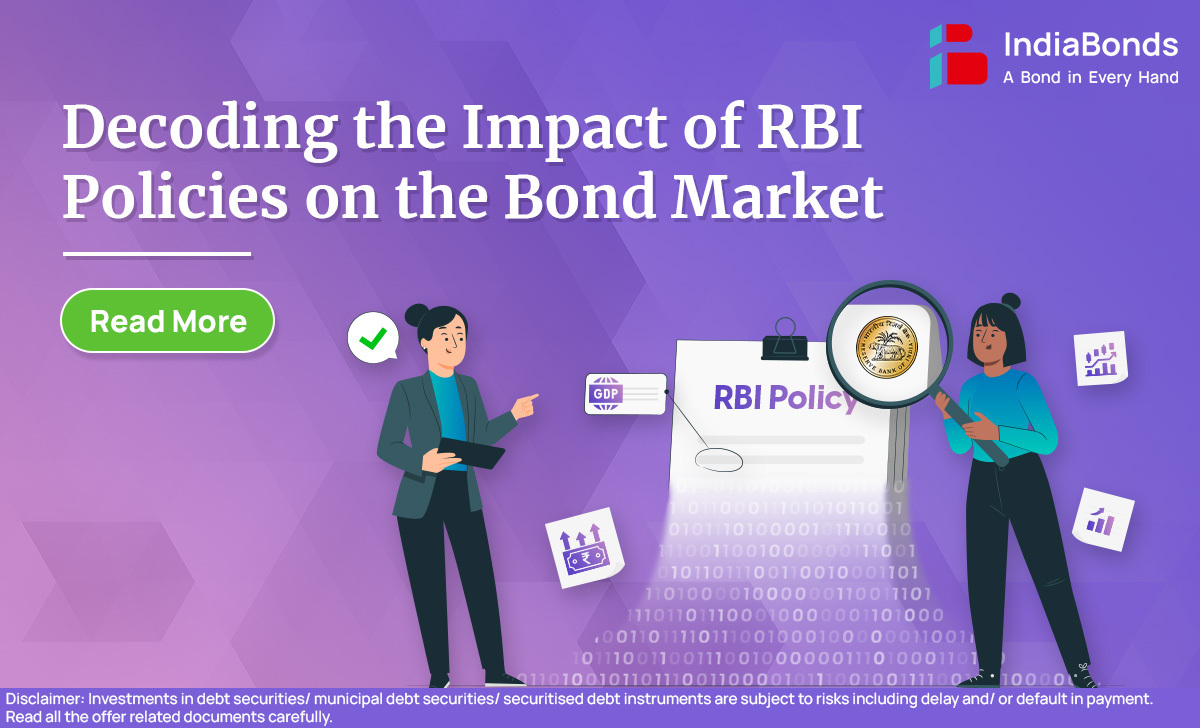
Imagine you’ve just bought a 10-year government bond, expecting steady returns. A few months later, the Reserve Bank of India (RBI) announces an interest rate hike. Suddenly, the value of your bond starts dropping. You begin to wonder: how can a central bank’s decision influence the value of your bond? This question highlights the relationship between RBI policies and the bond market. As an investor, understanding how the RBI’s policies affect the bond market is key to making sound investment choices. The RBI, through its monetary tools, not only manages inflation and economic growth but also directly influences bond prices, yields, and liquidity. As inflation stabilizes and global forces play out, let’s explore the deeper economics behind RBI’s actions and how they ripple through the bond market.
The bond market, or the debt market, is a critical platform where governments, corporations, and institutions issue bonds to raise funds. A bond is essentially a loan taken from investors, with the promise of repaying the principal along with periodic interest. Governments issue bonds to finance public projects, while corporations use them to fund expansion and operations. Government bonds are considered safer due to their backing of sovereign guarantee, while corporate bonds offer higher returns, reflecting their relatively higher risk. The bond market allows investors to buy and sell these bonds, and the RBI’s monetary policy decisions play a pivotal role in shaping this market’s dynamics.
At the heart of the bond market lies the law of supply and demand, a fundamental economic principle. Just like any other commodity, the price of bonds is determined by the balance between their supply and demand. When the government issues bonds, it increases the supply. If demand for these bonds is high, prices rise, and yields (the return investors get on bonds) fall. On the flip side, if demand is low or supply surges due to excessive government borrowing, prices fall, pushing yields higher. The demand from both domestic and foreign investors will dictate how yields adjust.
The RBI employs several tools to regulate the economy, primarily through its monetary policy. These tools, including the repo rate, reverse repo rate, Cash Reserve Ratio (CRR), and Open Market Operations (OMOs), are used to control inflation, manage liquidity, and stimulate or slow down economic growth.
The repo rate is the rate at which the RBI lends money to commercial banks. When the RBI increases the repo rate, borrowing costs rise for banks, which is then passed on to businesses and consumers, resulting in higher interest rates across the economy. When the RBI raises the repo rate, newly issued bonds come with higher yields, making older bonds with lower coupon rates less attractive. This leads to a decline in the price of existing bonds. Conversely, if the RBI lowers the repo rate, bond prices rise as investors seek to lock in higher-yielding older bonds.
The RBI uses Open Market Operations (OMOs) to manage liquidity in the banking system by buying or selling government securities. When the RBI buys bonds, it injects liquidity, increasing bond prices and lowering yields. When it sells bonds, it drains liquidity, pushing yields higher. When the RBI conducts OMOs to manage excess liquidity, selling government securities to absorb surplus funds, this causes a slight uptick in bond yields as liquidity conditions shifted.




One of the most critical drivers of bond prices is inflation. Inflation erodes the purchasing power of a bond’s fixed interest payments, making them less valuable over time. When investors expect inflation to rise, they demand higher yields to compensate for the loss of purchasing power, driving bond prices down. Retail inflation, or CPI inflation, dropped to a nearly five-year low of 3.64% in July 2024, falling below the RBI’s inflation target of 4%. If inflation spikes again, bond yields will rise as investors adjust for future price increases. Bonds with longer maturities are particularly vulnerable to inflation, as their fixed payments lose value over time.
During periods of economic uncertainty, investors often engage in a “flight to quality”, shifting from riskier assets like stocks or lower-quality bonds to safer government securities. This herd-like behavior can push up the prices of highly rated government bonds, particularly those issued by AAA-rated institutions, while the prices of riskier corporate bonds may fall. For instance, if the global economy faces turmoil in 2024, investors may rush to buy Indian government bonds, pushing their prices up and yields down. This phenomenon was observed during the pandemic and could repeat in response to future crises.
Apart from monetary policy, fiscal policy—the government’s use of spending and taxation—also plays a significant role in the bond market. Expansionary fiscal policy, which involves increased government spending, often leads to higher government borrowing. This raises the supply of government bonds, potentially increasing yields if demand doesn’t keep pace. Considering the government’s large borrowing target, bond yields may face upward pressure unless there’s strong investor demand. If borrowing continues to grow, it could lead to a crowding out effect, where government borrowing reduces the funds available for private sector investments, pushing up interest rates across the economy.
The business cycle—which includes stages of expansion, peak, contraction, trough, and recovery—affects bond yields and prices throughout its phases. During an expansion, demand for credit rises, pushing bond yields up. In contrast, during a recession, the RBI might lower interest rates to stimulate growth, driving bond prices higher as yields fall. Investors must watch for signs of a peak, as a contraction could lead to falling yields and rising bond prices.
In 2024, the bond market is shaped by a complex interplay of RBI policies, inflation trends, government borrowing, and global economic forces. Recently, with the inclusion of Indian government bonds in JP Morgan’s Emerging Market Bond Index (EMBI), the market has received a major boost, increasing its visibility among global investors. This, coupled with the fact that we are at or near the peak of the interest rate cycle, adds another layer to the bond market movements. Furthermore, the burgeoning private credit market and the growing awareness of bonds as a viable asset class among retail investors are contributing to heightened activity in the bond market.
As a result, one can anticipate a “cocktail of reactions” from both domestic and international investors, influenced by shifting global dynamics and local market conditions. While these factors introduce volatility and uncertainty, they also signal immense potential for growth. Whatever the immediate market reactions may be, the Indian bond market is poised for long-term success.
With inflation stabilizing and the RBI holding interest rates steady, the bond market presents both opportunities and risks. Rising awareness of bonds among retail investors, coupled with increased participation from international markets, is transforming the landscape. However, fiscal pressures due to elevated government borrowing and global uncertainties like fluctuating oil prices and geopolitical tensions continue to pose challenges.
For bond investors, understanding these interconnected dynamics is crucial for making informed decisions. By closely monitoring RBI policy signals and remaining alert to broader economic developments, investors can better explore the evolving bond market scenario in India, which remains primed for growth amid both local and global shifts.
Disclaimer: Investments in debt securities/ municipal debt securities/ securitised debt instruments are subject to risks including delay and/ or default in payment. Read all the offer related documents carefully.